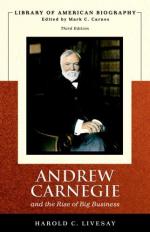
|
| Name: _________________________ | Period: ___________________ |
This test consists of 15 multiple choice questions and 5 short answer questions.
Multiple Choice Questions
1. Their deal demonstrates the power of what?
(a) Size.
(b) Intelligence.
(c) Ingenuity.
(d) Strength.
2. Carnegie tries to use public relations, legislative action and threatens who to drive shipping costs down?
(a) A competitor railroad.
(b) John D. Rockefeller.
(c) The unions.
(d) A competitor in the steel industry.
3. What firms are formed and the Gilded Age develops in New York?
(a) Restaurants and fast food chains.
(b) Bank and credit unions.
(c) Technology and communication.
(d) Retail and mercantile.
4. Carnegie leases the iron ore properties from this man. Why?
(a) To keep him out of the steel business.
(b) To keep him happy.
(c) To retire slowly from the industry.
(d) To make him a partner.
5. The Cyclops and Union Mills merger reduces time and labor cost of moving material and eliminates middlemen by _________ integration.
(a) Horizontal.
(b) Repetitive.
(c) Vertical.
(d) Circular.
6. Carnegie forces another _____________ partners out until only Schwab survives, while bringing in "young geniuses" who prove their merit on cost sheets.
(a) Eleven.
(b) Nine.
(c) Fifteen.
(d) Thirteen.
7. The 1878 Thomas process of lime-lining the heating vessel to eliminate phosphorous is acquired by Carnegie and sold to who two years later?
(a) The Bessemer Association.
(b) The Mellon Association.
(c) The Roosevelt Association.
(d) The John D. Rockefeller Association.
8. Other operating benefits like reduced inventory and less machine duplication create cost savings to enable __________________at a market-competitive rate.
(a) Reduced prices and reduced profitability.
(b) Reduced prices and increased profitability.
(c) Increased prices and increased profitability.
(d) Increased prices and reduced profitability.
9. Carnegie's pace of ___________ replacement needs continuous reinvestment of profits to the exclusion of significant dividend payments.
(a) Policy.
(b) Employee.
(c) Equipment.
(d) Management.
10. He follows a policy of putting all his eggs in the same basket and doing what?
(a) Worrying about it.
(b) Watching it.
(c) Forgetting about it.
(d) Ignoring it.
11. Carnegie's methods in steel concentrate what?
(a) The beginnings of the American steel industry.
(b) The first industry in the world.
(c) The beginnings of pollution problems.
(d) The first American industry.
12. When prosperity returns, the Carnegie business thrives. Does the damage to his personal reputation from the strike ever heal?
(a) Partially.
(b) Mostly.
(c) No.
(d) Yes.
13. Cost information enables cost-cutting per unit by __________________________ at the same output level.
(a) Increasing the speed of materials flow and decreasing labor cost.
(b) Increasing the speed of materials flow and increasing labor cost.
(c) Decreasing the speed of materials flow and decreasing labor cost.
(d) Decreasing the speed of materials flow and increasing labor cost.
14. William Coleman also shares Carnegie's interest and enthusiasm in what?
(a) Technology.
(b) Steel.
(c) Oil.
(d) Retail.
15. Frick shares Carnegie's vision and drive but is self-righteous and lacks what?
(a) A sense of humor.
(b) Confidence.
(c) Intelligence.
(d) Education.
Short Answer Questions
1. When Carnegie decides what furnace is more effective, he orders six more to be built immediately.
2. Bank failures destroy personal savings, social safety nets are nonexistent and workers retreat to the family farm or where?
3. Along with Shinn, they put together an effective team based on Carnegie's systematic analysis of personnel to provide performance incentives that raise __________ men through ranks to share ownership.
4. Carnegie is praised by labor leaders and Frick is considered _____________.
5. They make a deal that is considered what?
|
This section contains 537 words (approx. 2 pages at 300 words per page) |

|




